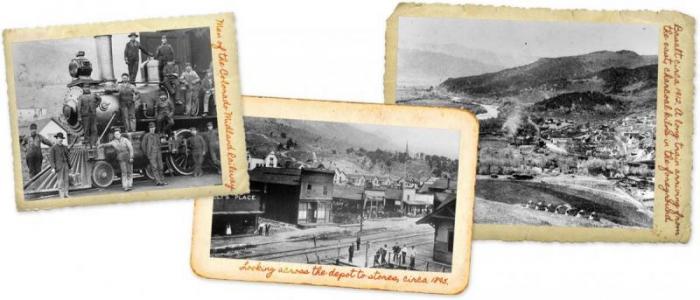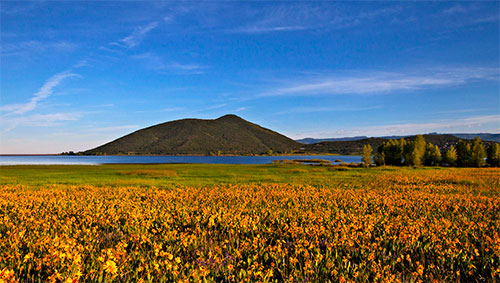Basalt Historic Walking Tour
Get Started on Your Self-guided Basalt Historic Walking Tour
In the late 1800s, settlement of the West was influenced by many factors: miners looking for precious metals, ranchers proving meat, grains, and vegetables, and the railroad, which served both. Railroads became lifelines that carried ore, supplies, and people. Fryingpan was the first settlement built in 1882 on the south side of the Fryingpan River created to house the men working the charcoal kilns that still remain today. Look for the bear paws on the sidewalk around town, pick up a map and start your tour at the kiosk next to the Basalt Chamber’s red caboose.
Colorado Midland Railway

In 1883, the Colorado Midland Railroad (CMR) was created from Colorado Springs to Buena Vista. In 1885 the CMR began tunneling between towns, linking east and west Colorado. The railroad was constructed to serve the growing mining industry and to efficiently ship agricultural products.
Wye
The triangle of land in the center of Basalt where the red Basalt Chamber caboose office and welcome center sits was the original Wye, three tracks where trains could be turned around. By 1886 Aspen Junction (present-day Basalt) began to form with a “boarding house, general store and seven saloons.” The town was a railroad camp, housing crews needed for the construction of the CMR.
Colorado Midland Depot

Constructed in 1886, the railroad depot was the first passenger loading area and mail station in the central valley. Many newly arrived residents spent their first night on the benches of the depot. As the transportation hub of the valley, the depot was a source of pride and the center of the town. In 1892, fire devastated the western end of town completely destroying the depot which was quickly rebuilt.
Swinging Bridge
In 1880, prior to Basalt’s formation, a one-lane post-and-beam wooden structure was built over the Fryingpan River as a wagon bridge for horse and stage traffic passing from Aspen to Glenwood. Regular wash-outs of the bridge resulted in frequent reconstruction. The town replaced it in 2001 with the existing state-of-the-art swinging bridge. Still used by residents to access the school and downtown, the Swinging Bridge has become a cherished part of Basalt.
Working Bridges
In the 1800s, bridges were a crucial lifeline for commerce and travel, and the untamed rivers often washed them away in the spring. In 1937, the Colorado Highway Department acquired the original railroad bridge where it crossed the Fryingpan just above its junction with the Roaring Fork and converted it to a highway automobile bridge. Highway 82 became the main route for traffic up and down the valley.
Charcoal Kilns
In 1880, 900 Aspenites were employed in the silver mines. The mining produced raw ore which required initial smelting before being shipped for refinement. Demand from the Aspen smelters for refining charcoal, which burns hotter than wood, resulted in the construction of seven kilns in Basalt by the Aspen Silver Co. in 1884. The availability of fuel from the vast stands of pine and pinion trees was the main reason for the selection of this site. The kilns were constructed of unfired brick and native stone. They appear to have been constructed with an outside coating of standard mortar for protection from the elements.
The Railroad Hotel

The Colorado Midland Hotel was constructed in 1896 to service the growing needs of Basalt. Originally owned by Dr. Thompson and Mr. Bear, the hotel had 10 sleeping rooms, a dining hall, and a saloon. Rumor has it that ladies of the night could often be seen up and down the stairs as the saloon below provided ample customers. Throughout the Quiet Years, the hotel had many owners and uses, but in 1965, as the upper-valley ski areas began to generate more economic growth, the hotel was returned to a restaurant with upstairs apartments.
The Aostans
While mining and railroads provided stimulus to the Basalt economy, early ranchers and farmers were the backbone of our culture and carried the valley’s economy from the early 1900s until the ski days. Notably, the small Italian valley of Aosta, a region of northwest Italy in the Western Alps, provided a number of families that framed our future. Seeing similarities to their homeland, they recognized its potential for an agricultural lifestyle rather than the unfamiliar miners’ lives they lived in Aspen. They began to find opportunities to purchase and settle farm and ranch lands.
Luchsinger Halfway House
In the early 1880s, the Luchsingers built a halfway house to house passengers on the stage line that traveled from Glenwood to Aspen. The house was the first home constructed in the central valley and what is now Basalt. The Luchsingers probably housed some of the men who worked in the charcoal kilns.
Snell Building
Constructed as a residence circa 1890, Frank Snell’s home was destroyed in the fire of 1897 that devastated the western end of Basalt. Frank, an engineer for the Colorado Midland, rebuilt his new home of brick. Little has changed today except for its use.
Splendid Spud
By 1922, more potatoes were grown in the valley than any other crop. While cattle were a more profitable source of income, almost all locals allocated a part of their lands for potatoes. Well-drained and with adequate water for irrigation, the potato thrived and carried many a family through the Great Depression. At its peak, the Roaring Fork Valley shipped over 3.5 million pounds of potatoes to other markets each year. Although a simple crop, the potato required extensive labor and long working hours during the growing and harvesting season.
Ranchers
 While mining and railroads provided stimulus to the Basalt economy, the ranchers and farmers of the valley have provided the consistent backbone of our culture and economy. Arriving in the valley in 1880, settlers found rich soil and good grass. By 1881, 20 families had acquired land, intending to settle and create their lives as farmers and ranchers. More arrived through the 1880s, and soon they were running cattle and producing crops — vegetables and hay — for their own use and for the miners who began to flood the valley in their quest for minerals. Cattle production and grazing in the high country is still an important and honored part of Basalt’s culture.
While mining and railroads provided stimulus to the Basalt economy, the ranchers and farmers of the valley have provided the consistent backbone of our culture and economy. Arriving in the valley in 1880, settlers found rich soil and good grass. By 1881, 20 families had acquired land, intending to settle and create their lives as farmers and ranchers. More arrived through the 1880s, and soon they were running cattle and producing crops — vegetables and hay — for their own use and for the miners who began to flood the valley in their quest for minerals. Cattle production and grazing in the high country is still an important and honored part of Basalt’s culture.
This tour was provided by Bill & Kathy Hegberg, Pitt & Barbara Hyde, Gary & Susan Blackie, Basalt Regional Heritage Society and Bennett A. Bramson, author of Basalt – Images of America, published by Arcadia Publishing. Signed copies of Bennett’s book are available at the Basalt Chamber Caboose in Lions Park and local retailers.
by Bill & Kathy Hegberg, Bennett Bramson, Pitt & Barbara Hyde, Gary & Susan Blackie
And The Basalt Regional Heritage Society






